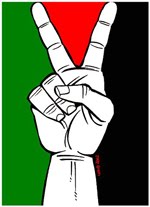Famous community organizer Saul Alinsky is known for developing skills for community organizing. His book "Rules for Radicals" describes common rules for tactics to topple he balance in favor of working classes pitted against financially powerful elites supported by legal establishment. Many of his rules appear crude and offensive, yet they represented only tools available to the oppressed. Many of these rules are relevant to the global Palestine freedom movement. Before we can have discussion on these rules, here are his famous rules as summarized on http://www.crossroad.to/Quotes/communism/alinsky.htm:
1. "Power is not only what you have, but what the enemy thinks you have."
2. "Never go outside the expertise of your people. When an action or tactic is outside the experience of the people, the result is confusion, fear and retreat.... [and] the collapse of communication.
3. "Whenever possible, go outside the expertise of the enemy. Look for ways to increase insecurity, anxiety and uncertainty. (This happens all the time. Watch how many organizations under attack are blind-sided by seemingly irrelevant arguments that they are then forced to address.)
4. "Make the enemy live up to its own book of rules. You can kill them with this, for they can no more obey their own rules than the Christian church can live up to Christianity."
5. "Ridicule is man's most potent weapon. It is almost impossible to counteract ridicule. Also it infuriates the opposition, which then reacts to your advantage."
6. "A good tactic is one your people enjoy."
7. "A tactic that drags on too long becomes a drag. Man can sustain militant interest in any issue for only a limited time...."
8. "Keep the pressure on, with different tactics and actions, and utilize all events of the period for your purpose."
9. "The threat is usually more terrifying than the thing itself."
10. "The major premise for tactics is the development of operations that will maintain a constant pressure upon the opposition. It is this unceasing pressure that results in the reactions from the opposition that are essential for the success of the campaign."
11. "If you push a negative hard and deep enough, it will break through into its counterside... every positive has its negative."
12. "The price of a successful attack is a constructive alternative."
13. Pick the target, freeze it, personalize it, and polarize it. In conflict tactics there are certain rules that [should be regarded] as universalities. One is that the opposition must be singled out as the target and 'frozen.'...
"...any target can always say, 'Why do you center on me when there are others to blame as well?' When your 'freeze the target,' you disregard these [rational but distracting] arguments.... Then, as you zero in and freeze your target and carry out your attack, all the 'others' come out of the woodwork very soon. They become visible by their support of the target...'
"One acts decisively only in the conviction that all the angels are on one side and all the devils on the other."
*****************************************************************************************************************************
Well-known activists who follow these traditions include democratic socialists Barbara Ehrenreich and Cornel West and left-libertarian egalitarians (libertarian socialists), best represented by the work of Noam Chomsky. Today, academics such as G. William Domhoff, Adolph Reed, Jr., and Jean Hardisty—as well as journalist-activists such as Holly Sklar, Roberto Lovato, and Amy Goodman—have refined the power structure research model inspired by Mills. What all of these perspectives share is an analysis of complex systems of power, rather than a fixation on individuals who may or may not be involved in conspiracies. As Domhoff observes, our “opponents are the corporate conservatives and the Republican Party, not the Council on Foreign Relations, Bilderbergers, and Bohemians. It is the same people more or less, but it puts them in their most important roles, as capitalists and political leaders,” where they are “readily identifiable and working through visible…institutions.”
*****************************************************************************************************************************
(The following is an important article on why we have to move beyond "conspiracy theories" and instead develop structural analysis of political events in the world)
Crackpots, the Left, and “Jewish Banker Cabals”
by Chip Berlet, Z Magazine, November 2007
A common perception is that the 1989 collapse of communism in Europe cast social change activists adrift without an ideological rudder. This is not accurate. For decades there have been other analytical frameworks used by organizers who stepped away from traditional Marxism and, instead, crafted approaches based in humanism, ecology, liberation theology, anarchism, and the politics of race and gender. C. Wright Mills’s famous study The Power Elite was published in 1956. Power structure research emerged from the student movement of the 1960s. Feminist theory, critical race theory, queer theory, and other models grew in the 1970s and 1980s.
Well-known activists who follow these traditions include democratic socialists Barbara Ehrenreich and Cornel West and left-libertarian egalitarians (libertarian socialists), best represented by the work of Noam Chomsky. Today, academics such as G. William Domhoff, Adolph Reed, Jr., and Jean Hardisty—as well as journalist-activists such as Holly Sklar, Roberto Lovato, and Amy Goodman—have refined the power structure research model inspired by Mills. What all of these perspectives share is an analysis of complex systems of power, rather than a fixation on individuals who may or may not be involved in conspiracies. As Domhoff observes, our “opponents are the corporate conservatives and the Republican Party, not the Council on Foreign Relations, Bilderbergers, and Bohemians. It is the same people more or less, but it puts them in their most important roles, as capitalists and political leaders,” where they are “readily identifiable and working through visible…institutions.”

No comments:
Post a Comment